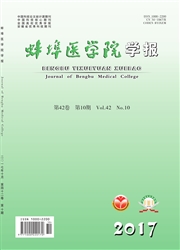

 中文摘要:
中文摘要:
目的:分析重症急性胰腺炎(SAP)患者腹高压(IAH)危险因素,并评估IAH对SAP患者预后的影响.方法:对58例SAP患者采用经尿道膀胱测压法间接监测腹内压值,反复或持续腹内压≥12 mmHg设定为IAH.记录第1个24 h 液体平衡、急性生理与慢性病Ⅱ(APACHEⅡ)评分、白蛋白值等与腹高压相关性高危因素.根据腹内压值,观察腹内压对患者感染率、多器官功能障碍发生率、血管活性药物使用、机械通气、急性肾损伤、住院时间、血培养阳性率、ICU时间及病死率等预后指标.结果:腹内压多因素logistic回归分析显示,入院第1个24 h液体平衡、APACHEⅡ评分和白蛋白值均是SAP发生腹内压升高的独立危险因素(P<0.05);而IAH患者多器官功能障碍发生率、血管活性药物使用、机械通气、急性肾损伤及住院、ICU时间均高于非腹高压患者(P<0.05~P<0.01).结论:入院24 h液体平衡、APACHEⅡ评分、白蛋白值均是SAP患者发生IAH的独立危险因素.及时解除可能引起腹内压升高的危险因素是治疗SAP的重要环节之一.
 英文摘要:
英文摘要:
Objective:To investigate the risk factors of intra abdominal hypertension(IAH) in severe acute panreatitis (SAP) patients and assess the prognosis of SAP patients with IAH. Methods: Fifty-eight SAP patients was monitored intra-abdominal pressure indirectly via urinary bladder pressure, repeated or continuous intra-abdominal pressure ≥ 12 mmHg was set as IAH. Multivariate logistic regression analysis was applied to analyze the effects of parameters including age, gender, acute physiology and chronic health evaluation Ⅱ (APACHE Ⅱ ) scores, 24 h fluid balance, hematocrit, serum calcium level on IAH. The influence of IAH on rates of operation, infection,multiple organ dysfunction syndrome, use of vasoactive agent, mechanical ventilation, acute kidney injury, positive blood culture, hospital duration, length of intensive care unit stay and mortality were also investigated. Results : The logistic regression analysis displayed, the first 24 h fluid balance, APACHE Ⅱ scores and serum albumin level were the independent risk factors for IAH in patients (P 〈 0.05), Moreover, patients with IAH had significantly longer average length of hospital and intensive care unit duration, higher rates of systemic and local complications and more invasive treatments compared with those without IAH( P 〈 0.05 to P 〈 0.01 ). Conclusions:The first 24 h fluid balance, APACHEⅡ score and serum albumin level were found to be independent risk factors for IAH in patients. It played the important role to relieve the possible risk factors of IAH promptly when treatment of SAP.
 同期刊论文项目
同期刊论文项目
 同项目期刊论文
同项目期刊论文
 Risk Factors and Outcome for Massive Intra-Abdominal Bleeding Among Patients With Infected Necrotizi
Risk Factors and Outcome for Massive Intra-Abdominal Bleeding Among Patients With Infected Necrotizi Codonopsispilosula polysaccharide attenuates cecal ligation and puncture sepsis via circuiting regul
Codonopsispilosula polysaccharide attenuates cecal ligation and puncture sepsis via circuiting regul Codonopsis pilosula Polysaccharide Attenuates Cecal Ligation and Puncture Sepsis via Circuiting Regu
Codonopsis pilosula Polysaccharide Attenuates Cecal Ligation and Puncture Sepsis via Circuiting Regu Nicotine ameliorates experimental severe acute pancreatitis via enhancing immunoregulation of CD4+ C
Nicotine ameliorates experimental severe acute pancreatitis via enhancing immunoregulation of CD4+ C 期刊信息
期刊信息
